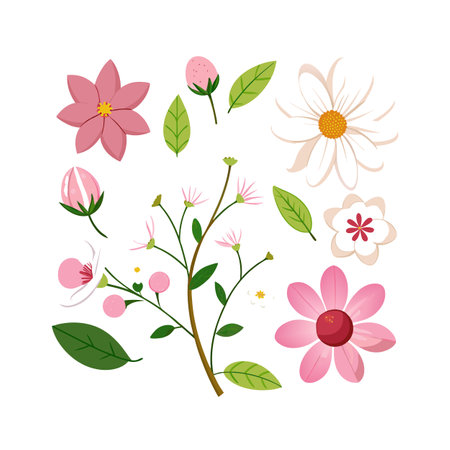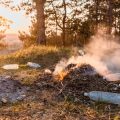Introduction to Spring Wildflowers in the U.S.
Every year, as winter fades and the days start getting longer, the United States transforms into a patchwork of color thanks to its spectacular spring wildflower blooms. From the rolling hills of California’s super blooms to the Bluebonnet fields of Texas, spring wildflowers mark a much-anticipated season for nature lovers across the country. Each region showcases its own unique palette: deserts erupt in vibrant color, mountain valleys fill with delicate blossoms, and woodlands come alive with carpets of trillium and violets. This seasonal phenomenon isn’t just beautiful—it’s a rite of passage for outdoor enthusiasts who flock to these natural displays for hiking, photography, and camping. Whether you’re an avid botanist or simply seeking an escape into nature’s artistry, experiencing spring wildflowers is one of America’s most cherished outdoor highlights. In this guide, we’ll explore what makes the wildflower season so special and why camping near these blooms is a must-do adventure for anyone looking to make unforgettable springtime memories.
Best Regions for Spring Wildflower Viewing
When spring arrives, America’s landscapes burst into color, and there’s no better way to experience this natural spectacle than by visiting regions famous for their wildflower displays. From the rolling fields of the Midwest to the vibrant meadows of California and beyond, each area offers its own unique palette of blooms. Here’s a closer look at some of the most iconic destinations for spring wildflower viewing, perfect for planning your next camping trip.
Pacific Northwest
The Pacific Northwest is renowned for its lush scenery and diverse flora. Places like Washingtons Mount Rainier National Park and Oregons Columbia River Gorge explode with lupines, Indian paintbrushes, and avalanche lilies from late March through June. The region’s mild climate and abundant rainfall create ideal conditions for wildflowers, making it a must-visit for nature lovers.
California
No list would be complete without mentioning California’s legendary superblooms. Anza-Borrego Desert State Park and Carrizo Plain National Monument transform into seas of poppies, desert lilies, and goldfields during peak bloom season (typically March to April). Joshua Tree National Park also dazzles visitors with its desert marigolds and lupines. These parks offer developed campgrounds as well as backcountry sites for an immersive wildflower experience.
Texas Hill Country
Texas Hill Country becomes a patchwork quilt of bluebonnets, Indian paintbrushes, and coreopsis every spring—usually from late March through mid-April. Highways around Fredericksburg and Llano are lined with blooms, while state parks like Inks Lake and Pedernales Falls provide great base camps for exploring the region’s floral beauty. Local towns even host festivals celebrating wildflower season.
Midwest
The Midwest might surprise you with its vibrant prairies and woodlands alive with color in springtime. Illinois’ Midewin National Tallgrass Prairie, Minnesota’s Blue Mounds State Park, and Missouri’s Ozark National Scenic Riverways are top spots to see coneflowers, shooting stars, and wild indigo. These locations feature both established campgrounds and rustic campsites surrounded by native blooms.
Quick Comparison of Wildflower Hotspots
| Region | Best Time to Visit | Notable Wildflowers |
|---|---|---|
| Pacific Northwest | April-June | Lupine, Paintbrush, Avalanche Lily |
| California | March-April | Poppy, Goldfield, Desert Lily |
| Texas Hill Country | Late March-Mid April | Bluebonnet, Indian Paintbrush, Coreopsis |
| Midwest | April-May | Coneflower, Shooting Star, Wild Indigo |
No matter where you choose to explore this spring, these regions promise unforgettable sights and memorable camping experiences amidst America’s most spectacular wildflower blooms.

3. Top Wildflower Species to Look For
Springtime in the United States brings a spectacular display of wildflowers, and knowing what to look for makes your camping adventure even more rewarding. Here are some of the most popular wildflower species you’re likely to encounter on your spring camping trips, along with tips for identification and a bit of fun trivia to share around the campfire.
Bluebonnets
The Texas state flower, bluebonnets (Lupinus texensis), are famous for carpeting fields in deep blue hues from late March to April, especially throughout central Texas. Spot them by their distinctive lupine-shaped leaves and clusters of blue blossoms tipped with white. Fun fact: It’s considered good luck in Texas to take a family photo among the bluebonnets each spring!
California Poppies
Nothing says spring in California like the vibrant orange of California poppies (Eschscholzia californica). Look for silky, cup-shaped blooms that close up on cloudy days or at night. These flowers love open, sunny hillsides and roadsides. The poppy is so beloved it’s actually California’s state flower, and picking them is discouraged in state parks!
Lupines
Lupines aren’t just a Texas treasure—these purple, blue, or pink spires can be found throughout the West, often alongside poppies. Their tall stalks and palmate leaves make them easy to spot. Did you know? Lupines help enrich the soil by fixing nitrogen, making them an essential part of local ecosystems.
Indian Paintbrush
This showy wildflower (Castilleja spp.) boasts fiery red or orange bracts that look like they’ve been dipped in paint. You’ll find Indian paintbrush across prairies and meadows from Texas all the way to Wyoming. Tip: The actual flowers are small and hidden within those colorful “brushes.”
Trillium
If you’re camping in eastern forests or the Pacific Northwest, keep an eye out for trillium. These elegant flowers have three white, pink, or purple petals and three broad leaves. Trillium is sometimes called “wake robin” because it blooms as robins return each spring. Remember: These plants are sensitive—admire but don’t pick!
Pro Tips for Flower Spotting
Bring a field guide or a plant ID app to help you identify what you find. Early morning or late afternoon offers the best light for both viewing and photography. And always remember to stay on designated trails to protect delicate blooms for future visitors.
4. Camping Hotspots for Wildflower Enthusiasts
If youre eager to experience the magic of wildflower season up close, choosing the right campground can make all the difference. Across the United States, several campgrounds and parks are not only renowned for their spring blooms but are also perfectly situated for easy access to some of the best wildflower hikes and vistas. Here are top recommendations for nature lovers looking to pitch a tent or park an RV amid vibrant meadows and blooming trails.
| Location | Best Time to Visit | Notable Wildflowers | Camping Experience |
|---|---|---|---|
| Anza-Borrego Desert State Park, CA | Late February – Early April | Desert Sunflower, Dune Evening Primrose | Primitive campsites, nearby trails with sweeping flower fields |
| Great Smoky Mountains National Park, TN/NC | Mid-April – Early May | Trillium, Lady Slippers, Foamflower | Diverse developed campgrounds and backcountry options near wildflower-rich valleys |
| Mount Rainier National Park, WA | July – August (higher elevations) | Lupine, Indian Paintbrush, Avalanche Lily | Scenic campgrounds like Cougar Rock with quick access to flower-filled meadows |
| Hill Country State Natural Area, TX | March – April | Bluebonnet, Indian Blanket, Coreopsis | Rustic campsites surrounded by rolling hills and colorful fields |
| Crested Butte, CO | Late June – July | Columbine, Lupine, Paintbrush | Tent and RV camping near famous wildflower hiking routes in “The Wildflower Capital of Colorado” |
Why These Spots Stand Out?
Each of these destinations offers more than just a place to sleep—they provide immersive experiences where you can wake up surrounded by blossoms and hit the trails at sunrise before the crowds arrive. Many parks feature ranger-led wildflower walks during peak bloom, so check their event calendars for special tours or educational programs.
Campsite Tips for Wildflower Seekers:
- Book Early: Spring is prime time; reservations fill quickly at popular parks.
- Pack Light Layers: Weather can be unpredictable in flower-filled mountain valleys or deserts.
- Respect Nature: Stay on marked trails to protect fragile blooms and avoid picking flowers.
Your Next Wildflower Adventure Awaits!
No matter which region you choose, these camping hotspots promise unforgettable spring mornings filled with color and fragrance. Grab your camera, lace up your boots, and get ready to immerse yourself in America’s most spectacular wildflower displays right outside your tent flap.
5. Best Times to Visit for Peak Blooms
Timing your camping adventure to coincide with peak wildflower blooms can turn a good trip into an unforgettable one. Because spring wildflowers depend on both climate and elevation, the best time to catch them varies across the country. In California’s low-elevation deserts like Anza-Borrego or Joshua Tree, blooms typically start as early as late February and can last through March, depending on rainfall. As you move north or climb higher in elevation—like the Sierra Nevada foothills or Pacific Northwest forests—peak wildflower season shifts to April, May, and even June.
Western United States
In places like Texas Hill Country and the Great Smoky Mountains, early to mid-April is usually prime time for bluebonnets and trilliums. The Rocky Mountains are a little later; aim for June or even July at higher elevations when snowmelt nurtures vibrant meadows of lupine and Indian paintbrush.
Midwest and Northeast
The Midwest bursts into color by late April through May, especially in prairie preserves and state parks. In New England’s woodlands, look for trout lilies and bloodroot from mid-April to early May, while higher elevations around the Adirondacks bloom in late May into June.
Tips for Planning Your Trip
Always check local wildflower reports or park websites for up-to-date information—bloom times vary year to year based on weather conditions. If you want a flexible itinerary, consider booking campgrounds with nearby trails so you can explore different elevations over several days. No matter where you’re headed, timing is everything: plan your trip around local bloom forecasts to make the most of spring’s spectacular show.
6. Leave No Trace and Wildflower Etiquette
Tips for Respecting Natural Habitats
When you venture out to see spring wildflowers, it’s crucial to remember that these beautiful blooms are part of a delicate ecosystem. Always stay on marked trails and avoid stepping off the path, even if that perfect patch of flowers seems just a few steps away. Trampling can damage root systems and prevent future growth. Camp only in designated areas, and keep your campsite tidy to minimize your impact on the landscape. If you’re bringing pets along, keep them leashed and ensure they don’t disturb wildlife or sensitive plant life.
Responsible Photography
Capturing wildflowers in their natural setting is a favorite activity for many campers, but it’s important to do so responsibly. Never pick flowers or uproot plants for the sake of a photo or souvenir—leave them for others to enjoy and for pollinators that rely on them. When taking pictures, try to use zoom lenses instead of getting too close, which can inadvertently crush surrounding vegetation. Be mindful not to block trails or cause congestion while setting up your shot.
How to Enjoy Wildflowers Without Disturbing Ecosystems
The best way to enjoy spring wildflowers is by observing them respectfully. Avoid making loud noises or playing music that could disturb wildlife. Take only memories and photos—leave everything else as you found it. Educate yourself and your group about native species and why protecting them matters. If you come across educational signs or ranger-led programs, take the opportunity to learn more about the local flora and how to be a better steward of these special places.
Quick Tips for Wildflower Etiquette
- Stay on marked trails at all times
- Don’t pick or trample wildflowers
- Pack out all trash and belongings
- Keep pets leashed and under control
- Use established campsites only
Be an Advocate for Conservation
Your actions set an example for others who want to experience wildflower season. Share your knowledge of Leave No Trace principles with fellow campers, friends, and family. By respecting natural habitats, practicing responsible photography, and following proper etiquette, you help ensure that America’s stunning spring wildflower displays remain vibrant and healthy for generations to come.


